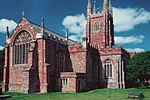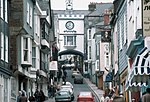Totnes Museum

Totnes Museum (formerly Totnes Elizabethan House and Museum) is a local museum in the town of Totnes, south Devon, in southwest England. The museum is housed in a Grade I listed Elizabethan merchant's house that was built c.1575 for the Kelland family. The house still has many original features. In 1958 Totnes Town Council purchased the Elizabethan House and carefully restored it to its former glory. In 1961 the Elizabethan House would open to the public as Totnes Museum. Today Totnes Museum is run by the charitable organisation Totnes Museum Trust and is free admission. Totnes Museum extends over two buildings and three floors including twelve gallery rooms, a courtyard, and a herb garden. Towards the back of Totnes Museum is Totnes Archive. The collections date from 5000BC to the present day. These range from early archaeological finds, coins minted in Totnes during Saxon times, Elizabethan artifacts and Victorian ephemera. The museum aims to entertain and educate visitors with the cultural, economic, and social history of Totnes. The museum various museum galleries include the Forehall, a Kitchen exhibition and the Babbage Room, which presents a history of Charles Babbage, the Victorian mathematician who invented the Difference Engine and Analytical Engine, working with Ada Lovelace. This was the mechanical precursors of the modern computer. Babbage spent his youth in Totnes and studied at King Edward VI Grammar School there.
Excerpt from the Wikipedia article Totnes Museum (License: CC BY-SA 3.0, Authors, Images).Totnes Museum
Fore Street, South Hams
Geographical coordinates (GPS) Address External links Nearby Places Show on map
Geographical coordinates (GPS)
| Latitude | Longitude |
|---|---|
| N 50.43134 ° | E -3.68662 ° |
Address
Totnes Museum
Fore Street
TQ9 5RU South Hams
England, United Kingdom
Open on Google Maps









